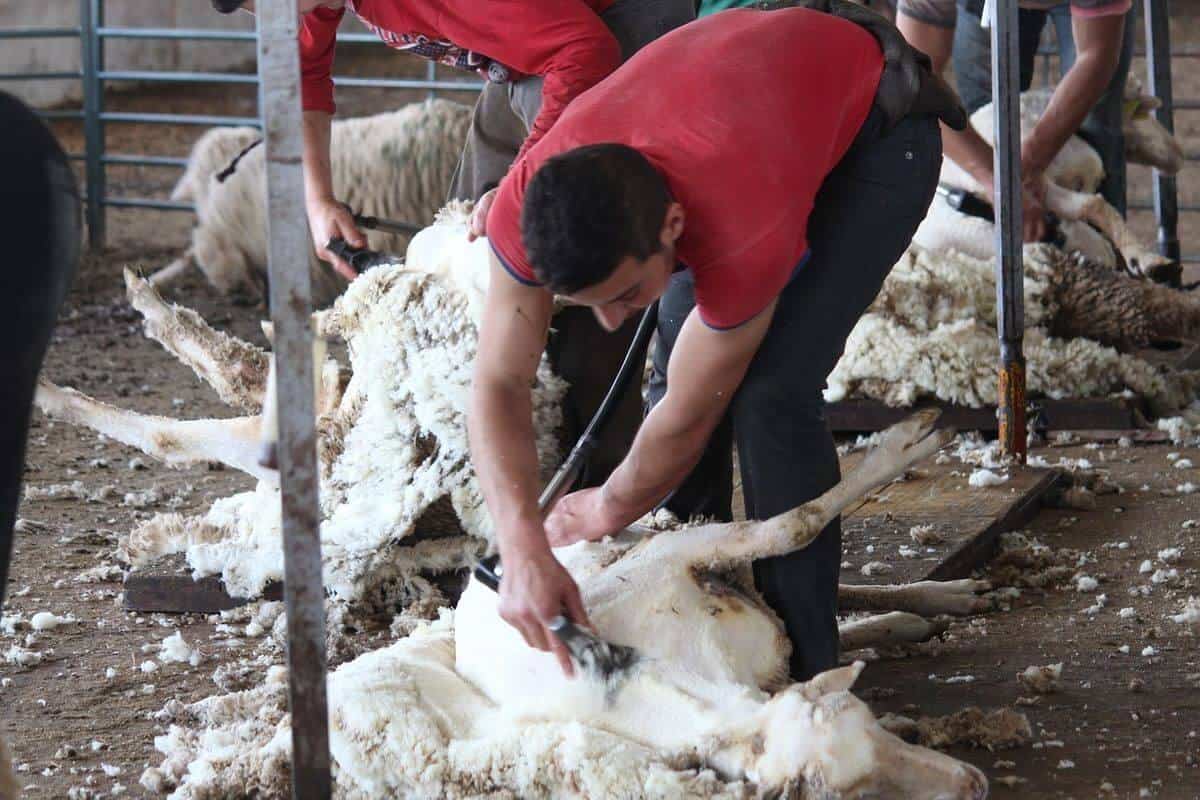It’s important to learn how to sheer a sheep properly. Sheep don’t shed on their own. Shearing in the spring will keep them cool in the summer with enough time for the fleece to grow to keep them warm in the winter.
In addition to keeping them cooler, it prevents wool blindness and keeps them cleaner as dirt, manure, etc. won’t be embedded in the wool.
Wool quality varies. Longer fibers (around 3 – 3.5 inches) are more valuable. Because sheared wool can be a source of income for the farm, beginners should start with sheep that have shorter wool lengths.
Before attempting to shear on your own, educate yourself:
- Hire a professional shearer to come to your farm; watch, ask questions, and learn.
- Contact a local sheep breeders or producers association and find a shearing demonstration at a farm or community event.
- Attend a shearing school. Find out the level of experience that’s required before signing up.
Sheep farmers with high-quality wool breeds such as Merino and Rambouillet may want to consider selling their wool. In these instances, it may more sense to hire a professional shearer instead of DIY-ing it.
Hire a Professional for the First Time
Professional sheep shearers can shear 5 – 10 sheep in 30 minutes. An inexperienced person will take much longer. If you have a small flock, it might be challenging to find someone to come out. Oftentimes, several farmers will get together to make it worth the shearer’s time.
They can be surprisingly cost-effective and generally charge per head of sheep.
Sheep shearers are good at what they do and make the process seamless. It will also save you from having to make second cuts.
It’s Labor-Intensive
Sheep shearing is hard work. No matter how skilled you are at shearing sheep, the entire process is challenging, and it takes a toll on the body. If you learn how to shear a sheep the right way, it will go more smoothly.
This work isn’t for everybody. If you find that your back is suffering after every shearing season, or if the number of sheep on your small farm has grown beyond your ability, hire a professional sheep shearer.
It’s still a good idea to educate yourself on the process. Here I explain how to shear sheep step-by-step to decide if this is something you want to handle in-house with your flock.
Consider the Wool Quality
If you are a beginner and have no experience shearing sheep, you should consider if you want to sell the wool. Merino sheep and Rambouillet sheep produce some of the most desirable wool. Other breeds with desirable wool are Blue Faced Leicester, Corriedale, Debouillet and Corno.
Learn the basics of wool quality. The length and color of the wool (with longer fibers and white wool being more valuable) significantly affect its market value. Fibers measuring around 3 – 3.5 inches are deemed staple length and hold more value than their shorter strands.
If you have different sheep breeds on your farm, you may want to begin and practice on sheep with less desirable wool.
To maximize profits for your sheep farm, you want to collect the highest-quality wool possible. It may make sense to hire a professional sheep shearer (they charge per head of sheep) to maximize profits. Another advantage is you can watch and learn from them.
What to Use to Shear
There are several sheep shear tools you can use:
- Electric shears
- Blade shears
- Scissors
Blade shearing is often quite challenging, but some farmers prefer it.
Preparations for Sheep Shearing Day
If you are shearing the sheep yourself and have more than a few sheep heads to shear, there’s a good chance that this work will take several days, if not weeks. However, if you are using a professional shearer, it could take just a few hours.
Either way, there are some preparations to be made. Most often, farmers shear sheep in the spring.
Here are some steps you need to take to prepare for sheep shearing day.
Don’t Overfeed Them
Sheep shearing is a physical task requiring the sheep to be contoured into different shapes during the process. It’s, therefore, easier on the sheep if they don’t have a full stomach.
However, that doesn’t mean they need to be hungry; they’ll become too restless that way. You need to feed them a little hay to keep them calm but stuffed.
Keep the Sheep Dry
Depending on the number of sheep you have on your farm, it’s best to have all the animals sheared in one location. Finding them in faraway pastures on shearing day will waste too much time.
It’s best to keep them in a shearing shed or shearing pen where they are not only easily accessible but also kept dry.
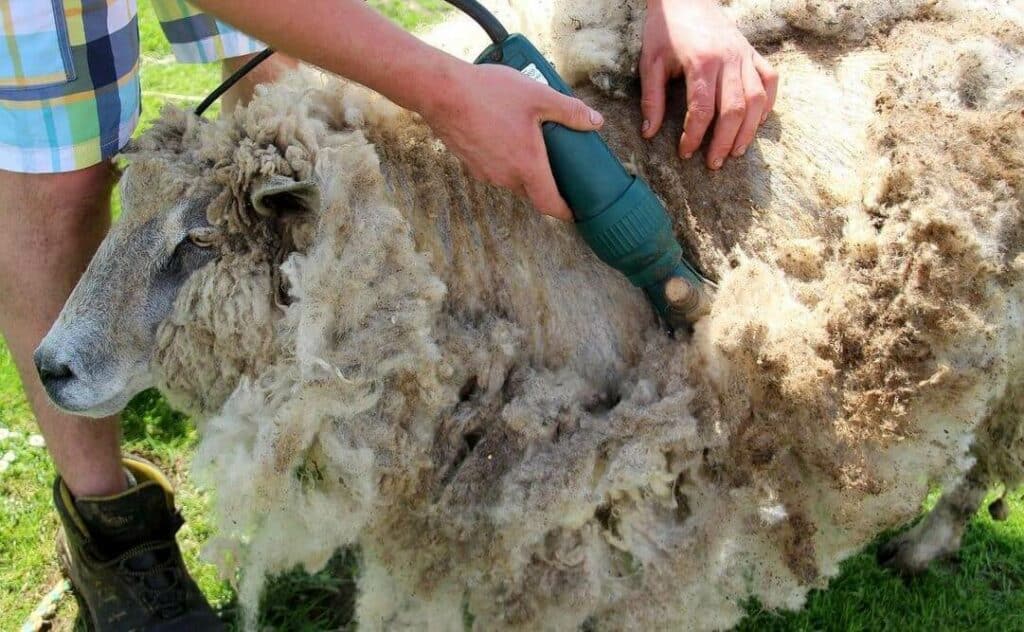
Have a Shearing Shed Ready
Prepare the shearing shed in advance. Don’t wait for the shearing process to begin to prep everything.
- If you use electric clippers instead of hand shears, have the extension cord connected to the power source and functional.
- The room should be cleaned / straightened.
- You should have the boxes or bags to collect the wool ready.
Ensure that the clippers or shears are in good working condition before using them on the animals. Use quality sheep shears designed to remove wool.
If you are using a professional shearer, alert them of any medical conditions such as CL (Caseous lymphadenitis) or other infectious diseases so they can take the necessary precautions.
How to Shear a Sheep for Beginners
Here’s a step-by-step guide on how to shear a sheep.
Step 1: Secure the Sheep on Its Rump
The very first thing you need to do is to sit the shear sheep down on its behind. Here’s how:
- Plant your feet wide apart on either side of the sheep’s shoulders
- Gently place your left thumb in the sheep’s mouth, behind the incisors, avoiding the molars, to guide its head.
- Firmly and carefully turn the sheep’s head back toward its shoulder to encourage it to sit.
- Support the sheep’s rump with your right hand, guiding it to the ground.
- As it starts to sit, lift its front legs to help it into a seated position on its rump.
- Use your knees to hold the sheep’s shoulders to stabilize it.
This position stabilizes the sheep, making it easier to manage during the shearing process and helps to reduce its stress.
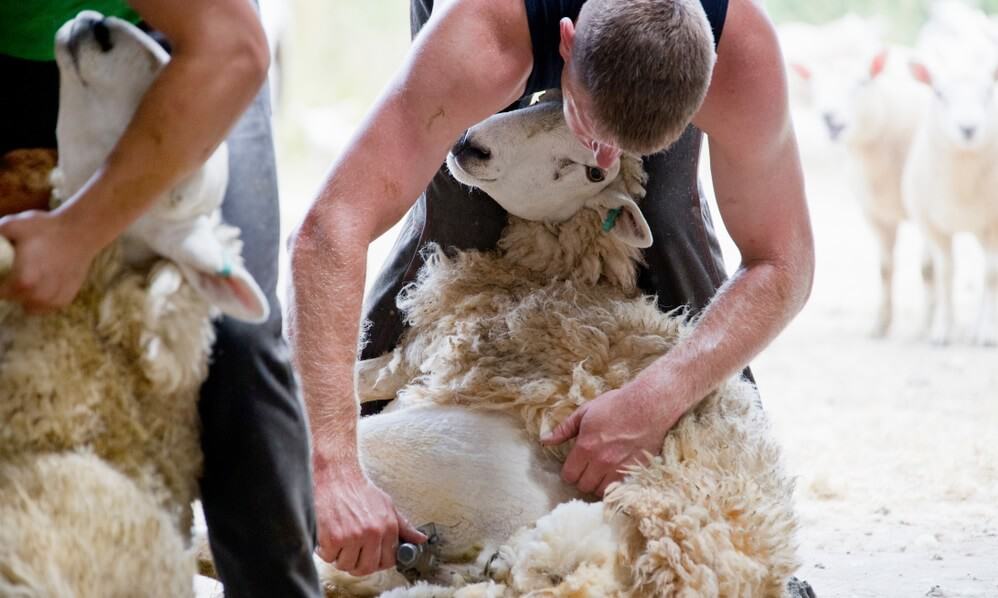
Step 2: Shear Between the Legs and Belly
Once you are done with those parts and are satisfied that you got all the belly wool, put the sheep back on its right hip. Let it lean against your legs as you keep supporting its shoulders with your knees.
This ensures a thorough removal of wool from sensitive areas, reducing the chance of cuts and helping ensure a clean shearing.
Step 3: Adjust Sheep for Neck and Head Shearing
After completing the belly and legs, you’ll need to reposition the sheep to access its head and neck.
- Ensure the sheep remains seated on its rump.
- Step closer, using your body to keep the sheep secure between your legs to add stability.
- Adjust the sheep’s position as needed to safely shear the head and neck. Maintain gentle control.
Securing the sheep in this manner provides better access to the head and neck, areas that require careful attention to avoid injury.
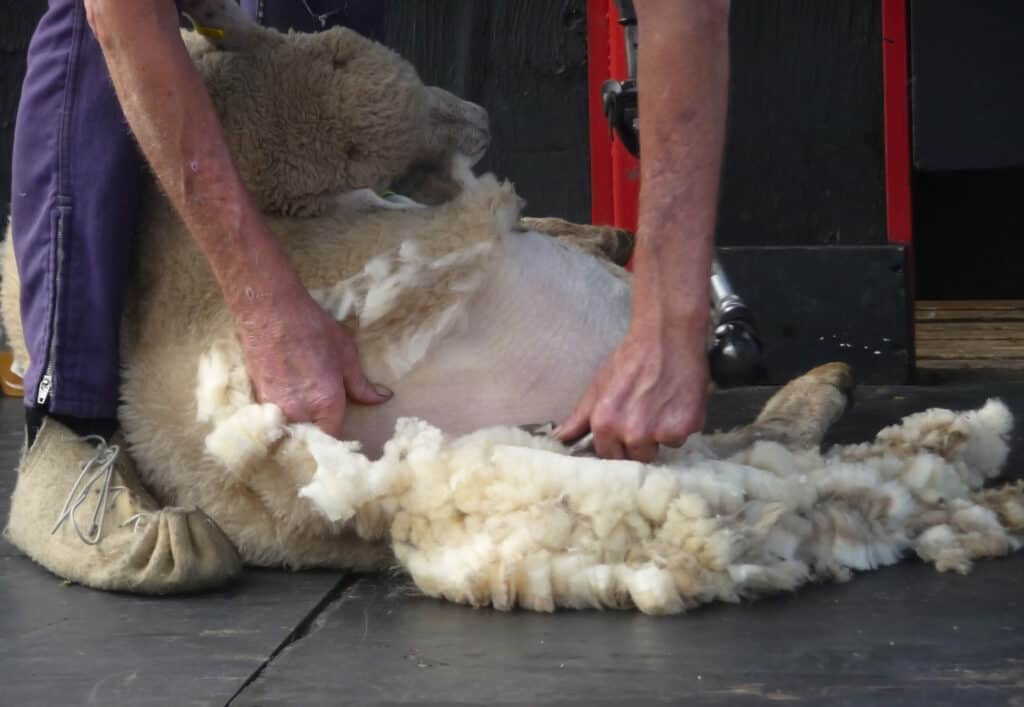
Step 4: Lay It Down on Its Right Side
When you are done with the sheep’s head, left shoulder, and neck, it’s time to lay it down on its right side. You must be careful when doing this and ensure that the sheep’s feet do not touch the shearing floor as you turn it.
This is because most domestic sheep find this position unnatural and will struggle once they sense that they can regain their footing.
- Keeping your right foot where it is, let the sheep down gently (only the front end).
- At the same time, step back using your left foot to support its right shoulder. This ensures that the sheep’s feet don’t touch the ground, resulting in struggling.
- Once you have the sheep in this position, use your shearing equipment to make long cuts along its back and side, going as far as you can without needing to roll the sheep.
This helps to maintain the sheep’s calmness throughout the shearing process.
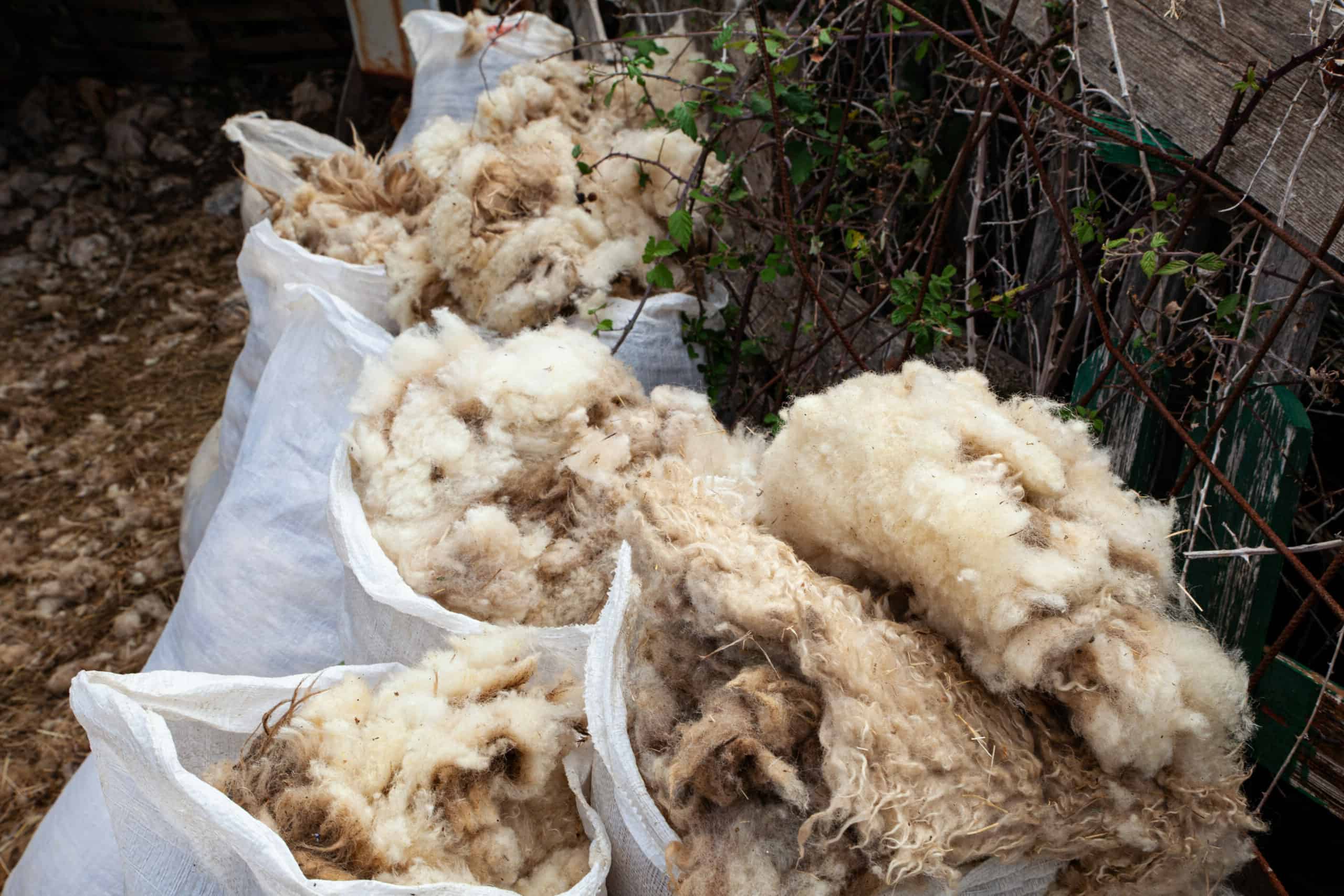
Step 5: Put the Sheep on Its Right Hip
At this point, you need to change the sheep’s neck and head position toward the other shoulder.
- Put your right foot out and pull it back toward the sheep’s body.
- Then gently pull its head up while bending its neck toward its left shoulder.
- Hold its head in that position using your legs.
- Once the sheep is secure, clean off the remaining wool or fleece from its head, neck, and right shoulder.
Adjusting the sheep’s position like this will help you efficiently shear the remaining areas, keeping the sheep as “comfortable” as possible.
Step 6: Finish Up
You should have a clear view of which body parts still need shearing. If you have done it according to these steps, all you need to shear will be the right leg, rump, and hip.
Once you are done, gently stand the sheared sheep up while supporting it with your hands as it gains its footing. This careful transition helps the sheep adjust after shearing. It will reduce the risk of injury as they regain their balance.
Take a good look at your handy work and decide whether or not you want to shear the rest of the flock yourself or hire a professional shearer to do it.
Remember, shearing is a skill that improves with practice. By starting with sheep that have less valuable wool, you can hone your technique before moving on to those with finer fleeces.
Why Do You Need to Shear Sheep
Shorn sheep are healthy sheep. It’s essential to shear sheep yearly. Some breeds may require it more frequently if their wool grows quickly. While it can be stressful for them, shearing doesn’t hurt sheep. It provides benefits such as:
- Keeps sheep cool in the summer
- Prevents them from overheating
- Prevents wool blindness
- Reduces parasites such as mites, ticks, lice, and maggots which can cause flystrike
- Keeps them overall cleaner – less feces, etc.
- Shearing before lambing can make it easier for the lambs to access the teats and can make it easier to milk sheep.
Hair sheep don’t need shearing; however, meat sheep breeds require it.
Can You Shear More Than Once a Year
If you shear sheep more than once a year, the fibers will be shorter. This affects the wool quality as long fibers are more desirable. If the quality of the wool isn’t as important, shearing them more often means the fleece will likely be cleaner.
Many sheep owners shear sheep every six months. It depends on the breed, goals for the wool, and your resources. Some may shear twice every three years.
Does Shearing Sheep Hurt Them
Shearing sheep does not hurt the sheep. However, it can cause stress and anxiety for them. Being organized with the workspace and shears, keeping the environment as calm as possible, and using the step-by-step directions to be sure it’s done properly can make things go easier.
Shorn sheep and sheared sheep will look different than sheep with their wool. Being shorn will keep them cooler in the summer and keeps them healthy. How long do sheep live
Here’s a sheep shearing video showing how to shear sheep properly:
Shearing Sheep Tips
It should be noted that the wool industry and the American Sheep Industry Association have strict guidelines on the quality of wool from ewes and lambs in general.
If you are raising domesticated sheep for their wool, shearing sheep skills should be at the top of your priority list. Thankfully, you don’t always have to do it yourself.
Many available professional shearers and shearing schools can guide you or even do it for you at a small fee.
Don’t let the excess wool on your sheep go to waste. You can make money from it, but it has to be done right. This guide should help.
Even if you intend to use a professional shearer on your farm, it’s always a good idea to learn the shearing process yourself so that you know what’s going on and be capable of doing it yourself should the need arise.
Always remember to maintain gentle control and ensure the sheep’s comfort, welfare, and safety. This is especially important when shearing around sensitive areas.

